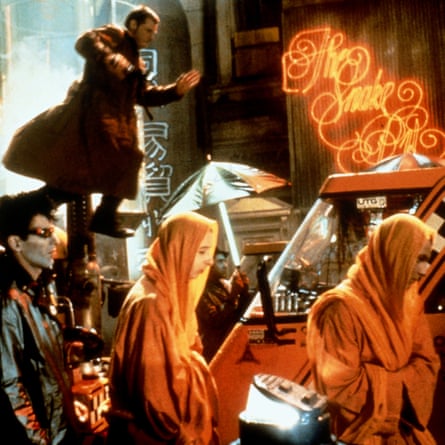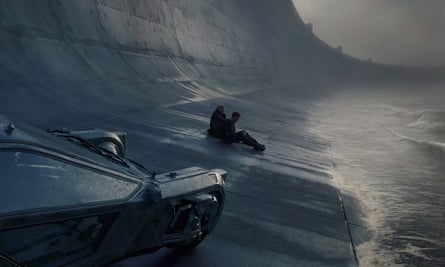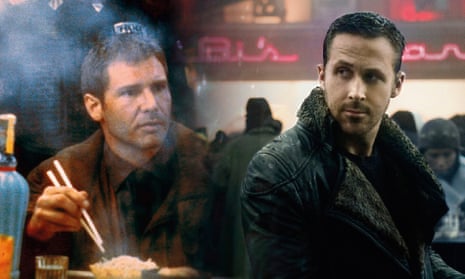On the face of it, dystopian movies are the hardest sell in cinema. Who wants to see a film telling you that everything goes wrong and we all live miserably ever after? But increasingly, it seems, that is what we want to see, looking at recent hit sagas such as The Hunger Games, Planet of the Apes, Divergent and now a Blade Runner sequel. The pill has to be sugared with spectacle and romance, but dystopian futures perform a function. They are the canary in humanity’s coal mine. They show us where we are going off-course and what we are afraid of – not in the future, but in the present. In the same way we are doomed to repeat history if we don’t understand it, perhaps we are doomed to end up eating each other if we don’t make Soylent Green.
Few people wanted to hear what the original Blade Runner had to say in 1982. The economy was beginning to come out of recession and Ronald Reagan was preparing to announce it was morning in America, but Blade Runner gave us a world where everything that could go wrong had gone wrong: environmental degradation, pollution, urban sprawl, corporate dominance, technology run amok – it’s the sum of all dystopias. No wonder audiences preferred the upbeat embrace of Spielberg’s ET.
But where most sci-fi movies quickly date, Blade Runner has improved with age. Of course, it was always a fantastic ride, superbly detailed and steeped in neo-noir atmospherics, but its deep, troubling ideas about technology, humanity and identity chimed with postmodern and cyberpunk theory, and launched a thousand PhD theses. One of the few student lectures I can remember was about the French theorist Jean Baudrillard, orders of simulacra, and how nothing is really real any more. In a down-with-the-kids gesture, the lecturer stood behind a TV monitor playing a muted video of Blade Runner. “You’ll probably get more out of watching this than you will by listening to me,” she said. She was right. Deciphering Baudrillard’s arcane prose is like wading through treacle; Blade Runner is a ride you don’t want to get off. And, against all odds, its belated follow-up, Blade Runner 2049, carries the baton brilliantly, both in terms of visual spectacle and finishing the debates the first movie began.
Between the two movies and Philip K Dick’s source novel, Do Androids Dream of Electric Sheep?, Blade Runner serves as a record of how our dystopian fears have evolved over the past half-century. When Dick wrote the story, in 1968, he was thinking of the dehumanising process of nazism. His “replicants” (artificially engineered humans with a four-year lifespan) were “essentially less-than-human entities”, Dick stated. They were “deplorable because they are heartless, they are completely self-centred, they don’t care about what happens to other creatures”.
Ridley Scott’s film turned it around, somewhat. Far from being a deplorable, heartless machine, Rutger Hauer’s chief replicant, supposedly the baddie, develops empathy for the cop trying to kill him. Replicants were the superior beings. “More human than human,” as their manufacturer, Eldon Tyrell, puts it. Apart from the four-year lifespan, what was the difference? This was the part Baudrillard and co were so keen to engage with: what was “real” when the copy was better than the original? “The real is not only what can be reproduced but that which is always already reproduced. The hyper-real,” wrote Baudrillard. Human status was no longer a matter of biological or genetic fact. You couldn’t trust your memories either – they could just be implants. So how do any of us know we are human?
These are realms where Hollywood sci-fi does not often venture – although HBO’s Westworld did a fine job of it on TV last year. They are far down the road from movies about dangerous technology, or artificial intelligence or malevolent cyborgs, or even space travel. We are talking beyond the final frontier.
But Blade Runner also added some very 1980s fears into the mix. Corporate power, for example, which had taken over from democratic government entirely. The threat of foreign economic powers overtaking the US also fed into Blade Runner’s melting-pot, multilingual Los Angeles, particularly Japan, which was then buying up chunks of the US, including Hollywood studios (a few years later, Scott would make the Japan-phobic thriller Black Rain). Fear of nuclear annihilation was also high in the 1980s, but if it hasn’t happened already in Blade Runner, it might as well have done. Anyone who could leave this barren planet has already done so. If we could go with them, we would be in a wondrous, intergalactic space adventure such as Star Trek or Guardians of the Galaxy. Instead, we are stuck down here with the dregs of humanity.

Thirty-five years on, many of those 1980s anxieties are ships that have sailed. Corporate influence has crept so far into politics that we accept it as the status quo. Foreign financial powers have encroached to the extent that Blade Runner 2049 is brought to you by Sony (as the product placement constantly reminds you). Nuclear annihilation? The cold war thawed out soon after, though the North Korea situation is threatening to bring it back.
We have got a new set of fears to feed into the dystopian machine now, and Blade Runner 2049 seems to have processed them. For a start, there is the fear of social relations in the digital age. Building on the first movie’s city planning, Los Angeles has become an even vaster metropolis here: a neon-lit, high-rise favela, crammed with people but starved of social interaction. The flying cars and giant holograms might be futuristic, but the vision of lonely, atomised urban life is familiar.
Our new hero is a replicant cop named K, played by Ryan Gosling. He has no friends, partner or family. His only real companion is Joi (played by Ana de Armas), a holographic girlfriend beamed into his cell-like apartment, who can switch from compliant housewife to sexy vamp in a flicker. (This might be in the mid-21st century but gender politics haven’t much moved on since the 19th – the city seems entirely geared towards pornified male sexual desire, which seems odd when replicants can’t reproduce anyway.) If K had seen Spike Jonze’s Her, he might realise his personalised dream girl is actually a mass-produced app who is probably simultaneously dating 50,000 other lonely guys around the city, but he doesn’t get out that much. Nor does anyone else, it seems.
And yet K’s relationship with Joi is the most sincere and romantic in the movie. Without wishing to give too much away, they participate in one of the most bizarre sex scenes ever filmed – somewhere between VR pornography and the dance scene in Ghost – that leaves you more confused than aroused. But he tells her he loves her, and we believe him. He isn’t “human”; she isn’t even non-human. All that’s real is the love.

It is no longer possible to gauge who is human or not any more in Blade Runner 2049, but it still matters. There is no four-year lifespan for replicants any more, and no Voight-Kampff test – the memorable interview process we saw in the first movie, which detected replicants by monitoring their eyes in response to emotive questioning. In its place, K has to recalibrate himself after each assignment by repeating a series of words barked at him by a faceless machine. Compared to the personal touch of the Voight-Kampff test, this is closer to scanning the alignment page on your printer. One of the few things that still distinguishes the replicants from humans is their inability to reproduce. They are second-class citizens in the eyes of (presumed) humans such as K’s police chief, played by Robin Wright.
“There is an order to things,” Wright tells K. “The world is built on a wall that separates kind. Tell either side there’s no wall, you’ve bought a war … or a slaughter.” Could she have been watching old Trump rallies? The heavily policed boundary in Blade Runner 2049 is less about humans and non-humans than haves and have-nots – again, a problem that the present day is all too familiar with.
As before, replicants are essentially mass-produced slave labour for the privileged. “Every great civilisation was built off the back of a disposable work force,” says Jared Leto’s replicant-manufacturing CEO. The statement is arguably no less true in 2017 than it will be in 2049, but we don’t talk about it much, either in our wealthy, post-colonial Europe that seeks to keep out the descendants of those off whose backs it was built, or in a US where slavery and segregation are relatively recent memories, which must be hammered down every time they resurface in the form of a Black Lives Matter protest.

As K goes about his investigations, we see more uncomfortable hints of a slave society supposedly taking place 30 years hence: silos of child labourers dismantling discarded electronic circuitry; scavengers living on giant scrapyards of rusting metal; female sex workers on the streets; a “protein farmer” eking out a miserable existence in the mud. We even see a cleaner at one point – possibly the first one ever to be spotted in a Hollywood sci-fi movie. This is our world, happening now.
Gosling’s K is by no means reduced to a social justice warrior of the future, but the theme of enslavement has been strong in recent dystopian movies. In The Hunger Games, we identify with the oppressed rural peasants presided over by the wealthy Capitol, just as we side with the subservient androids in HBO’s Westworld, and the persecuted primates in the recent Planet of the Apes saga, the slum-dwelling aliens in District 9, and the “so enslaved they don’t even realise it” humans of The Matrix.
Many of these stories nostalgically cling to an “original” state that its oppressed peoples are fighting to regain. In the case of The Matrix, that turned out to be a Burning Man-style rave that was less appealing than the virtual reality they were already in. In the recent Ghost in the Shell remake, Scarlett Johansson’s cyborg cop retraced her “original” self, whereas its anime predecessor leapt into a post-human unknown. But the boldest of them come to the same conclusions as Blade Runner: that humanity is no longer the exclusive preserve of humans. Apes or cyborgs or replicants might be better at being human than us, and that’s OK.
Beyond the Baudrillardian philosophising about “how do we know we’re human?”, Blade Runner 2049 asks what it means to be human, and it boldly ventures some suggestions. It is the ability to form connections, to empathise with others, to love, to have values. It is also the will to act, to resist, to fight for those values. “Dying for the right cause is the most human thing you can do,” says one character. It’s a call to revolution. Not tomorrow but now.
Brave new worlds: five great movie dystopias

Metropolis (1927)
The perils of modern society were all present in Fritz Lang’s epic, made 90 years ago: de-humanising technology, corporate control, inequality, cyborgs, capital v labour. Hugely ambitious for its time, it set the tone for all that followed – not least Blade Runner.
Brazil (1985)
Three years after Blade Runner, Terry Gilliam gave us another wondrously bleak future, mercifully played for laughs. This is Orwell’s Nineteen Eighty-Four as black comedy – a world choked by crippling bureaucracy, totalitarian control, bad cosmetic surgery and crap technology.
The Matrix (1999)
Cutting-edge special effects and postmodern philosophy combined to give us a dazzling dystopia for the digital age, whose suggestion that we are living in a computer simulation has yet to be disproved. Shame about the sequels.

WALL-E (2008)
Possibly the grimmest dystopia committed to film: a barren Earth habitable only by robots, while obese humans waddle about on an endless space cruise. Incredibly, Pixar managed to make it a charming, heartwarming, family-friendly animation.
The Hunger Games (2012-2015)
Updating the dystopian death games of Running Man, Rollerball and Battle Royale, the smash hit threw Jennifer Lawrence into televised gladiatorial battles at the behest of decadent imperial oppressors. Based on Suzanne Collins’s books, her bleak predicament chimed with young audiences and spawned three sequels

Comments (…)
Sign in or create your Guardian account to join the discussion